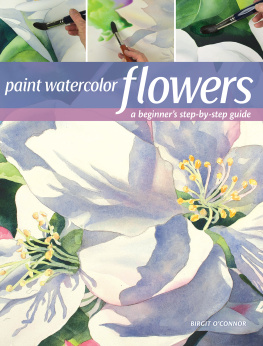Contents
Guide
Botanical
WATERCOLOR PAINTING
FOR BEGINNERS
A Step-by-Step Guide to Create Beautiful Floral Artwork
Cara Rosalie Olsen

For the creative souls and lovers of beauty,
most especially flowers, this book is for you.
Before we wade much deeper into the literal water of watercolor study, Id like to talk with you for a moment about something we will be revisiting again and again throughout this book: loose art.
For the sake of clarity, we should define the word loose, as it means different things to everyone. For some, loose, when applied to watercolor painting, could mean something abstract: highly gestural strokes with a goal to cast only the faintest mirage of something definitive. Or loose could mean a structure that plays with the boundaries of what is real and what could be if left to the imagination. If I were to label my own style, Id say Im more the lattersomeone who feels highly inspired by the shapes and movement of nature, but genuinely longs to tell her own story.
In this book, you will find that each lesson is merely a nod to the subject we are studying, never to be an exact facsimile. You arent trying to replicate a photo of an African violet, youre trying to convey an African violet as you perceive and feel it. This is intentional. Having studied botanical art for three years, it wasnt until I began allowing myself to break the rules that I found true joy in the process. Joy I want to share with you.
Art, any art, should be a representation of the one yielding the medium. It should look and feel like you.
Loose art is that for me. I see myself in indistinct shapes, not quite comfortable fitting inside boxes. I see myself in the tangle of leaves as an imperfect structure willing to share the beauty she has to offer. I choose to keep my art loose as a living testimony to the relentless beauty found in the odd and irregular.
A huge misconception about loose art is that its easier than more structured art, which is simply not true.
If anything, most will agree loose art can be more challenging because there is no right answer. There is a desired end result when botanically approaching a flower that doesnt exist in loose art. There are limitless ways to paint a rose, and whether they are good is highly subjective.
None of this is said to dissuade you, but rather to encourage you in continuing to explore the boundaries of your expression. Loose art is innately forgiving, meaning that even when you make a mistake, there is still room to make beauty with it. This is why I choose and teach this art formfor its capacity to offer grace to the artist every step of the way. There are no closed doors, only open windows.
Ive chosen to highlight loose art in this book for the freedom it provides, inviting you to be guided and inspired by nature, rather than her prisoner. Art should be forgiving. It should make you feel both powerful and vulnerable. It shouldnt be something that leaves you feeling you didnt hit the mark.
More than anything, I would like you to lean in to the mess. I promise to teach you all you need to know about the foundation of botanical watercolor painting, using loose art as the backbone to our projects, and in return I ask that you give yourself permission to take risks, even if they dont pan out. By this, you discover your process, and process is GOLD. Process is the reason we keep coming back, why we hunger to keep creating, keep learning. Contrary to belief, art isnt the finished resultits everything that led up to it.
So, are we ready to do this?
Then, brushes raised cheers to the mess and the magic! Its going to be beautiful, my friend.
The index that appeared in the print version of this title does not match the pages in your eBook. Please use the search function on your eReading device to search for terms of interest. For your reference, the terms that appear in the print index are listed below.
A
activation, of paint
African daisies
agapanthus
alstroemeria
aubrieta
autumn wreath
B
belly, of brush
bleeds
blending, of color
bluebird hibiscuses
boundaries
branches
brushes
C
chamomile
chrysanthemums
cold-press paper
color, about
Color Guides
color values
compound strokes
cool colors
cosmos
crimp, brush part
D
daisies
delphinium
E
erasers
eucalyptus, and lavender wreath
eucalyptus branches
eucalyptus leaf stroke
F
ferrule, brush
filler flowers. See flowers, filler
flower strokes
African daisy
lavender
pinwheel
rose
flowers. See also other flower headings; wreaths
agapanthus
alstroemeria
chrysanthemum
cosmo
Iceland poppy
striped flaming flag tulip
wild rose
zinnia
flowers, filler
aubrieta
delphinium
forget-me-nots
snowberry
yarrow
flowers, tropical
bluebird hibiscus
plumeria
tiger lily
flowers, white
African daisy
chamomile
hyacinth
ivory garden rose
white gerbera daisy
white magnolia
forget-me-nots
G
gerbera daisies, white
gestural stroke
glazing
H
handle, brush
hibiscuses, bluebird
hot-press paper
hyacinths
I
Iceland poppies
inspiration
ivory garden roses
L
lavender and eucalyptus wreath
lavender
leaf strokes
compound
gestural
positions of
simple
leaf wreaths
lilies
loading, brushes
loose art
M
magnolias, white
mixing, of color
movement
muddy colors
muted colors
O
outlining
P
paint
palettes
pans, of paint
paper
pencils
Peruvian lily
pinwheel flower
plumerias
poppies
positions
posture, brushes
pressure, brush
primary colors
priming brushes
R
ratios, water-to-paint
recipe, color
rewetting
roses
rough paper
S
saturation
secondary colors
simple stroke
sketching
snowberry
softening
striped flaming flag tulips
strokes
compound
flower (See flower strokes)
gestural
leaves
simple
supplies
T
tertiary colors
texture, of paper
tiger lilies
toe, brush
toolbox
tubes, of paint
tulips, striped flaming flag
V
values, color
variety
W
warm colors
Watercolor Supply Guide
water-to-paint ratios
wet-into-wet technique














